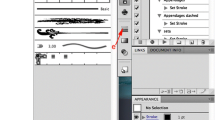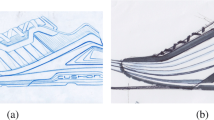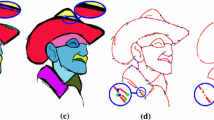Abstract
We propose here an efficient algorithm for high-level vectorization of scanned images of mechanical engineering drawings. The algorithm is marked by several novel features, which merit its superiority over the existing techniques. After preprocessing and necessary refinement of junction points in the image skeleton, it first extracts the graphic primitives, such as lines, circles, and arcs, based on certain digital geometric properties of straightness and circularity in the discrete domain. The primitives are classified into different types with all associated details based on fast and efficient geometric analysis. The vector set is succinctly reduced by such classification in tandem with further consolidation to make out meaningful objects like rectangles and annuli, together with hatching information. Exhaustive testing shows the efficiency of the algorithm and also its robustness and stability toward any affine transformation and injected noise. Easy reconstruction to scalable vector graphics demonstrates its readiness and usability as a state-of-the-art solution.






















Similar content being viewed by others
References
3rd/5th IAPR international workshop on Graphics RECognition (Arc Contest). http://www.cs.cityu.edu.hk/~liuwy/ArcContest (2003/2005)
7th IAPR international workshop on Graphics RECognition (Arc Segmentation Contest). http://www.iapr.org/arcseg2007 (2007) (The dataset was available in the website till 2007)
10th IAPR international workshop on Graphics RECognition (Line and Arc Segmentation Contest). http://grec2013.loria.fr/GREC2013/ (2013)
Al-Khaffaf, H., Talib, A.Z., Salam, R.A.: Removing salt-and-pepper noise from binary images of engineering drawings. In: Proceedings of Nineteenth International Conference on Pattern Recognition, pp. 1–4 (2008)
Al-Khaffaf, H.S.M., Talib, A.Z., Abdul. R.: Salt and pepper noise removal from document images. In: Visual Informatics: Bridging Research and Practice, volume 5857 of Lecture Notes in Computer Science, pp. 607–618 (2009)
Ballard, D.H.: Generalizing the hough transform to detect arbitrary shapes. Pattern Recognit. 13(2), 111–122 (1981)
Bhowmick, P., Bhattacharya, B.B.: Fast polygonal approximation of digital curves using relaxed straightness properties. IEEE Trans. Pattern Anal. Mach. Intell. 29(9), 1590–1602 (2007)
Bhowmick, P., Bhattacharya, B.B.: Number-theoretic interpretation and construction of a digital circle. Discrete Appl. Math. 156(12), 2381–2399 (2008)
Chinnasarn, K., Rangsanseri, Y., Thitimajshima, P.: Removing salt-and-pepper noise in text/graphics images. In: Proceedings of the IEEE Asia-Pacific Conference on Circuits and Systems, pp. 459–462 (1998)
Chowdhury, S.P., Mandal, S., Das, A.K., Chanda, B.: Segmentation of text and graphics from document images. In: Proceedings of the Ninth International Conference on Document Analysis and Recognition, vol. 2, pp. 619–623 (2007)
di Baja, G.S.: Well-shaped, stable, and reversible skeletons from the (3, 4)-distance transform. J. Vis. Commun. Image Represent. 5(1), 107–115 (1994)
Dori, D.: Orthogonal zig-zag: an algorithm for vectorizing engineering drawings compared with hough transform. Adv. Eng. Softw. 28(1), 11–24 (1997)
Dori, D., Liu, W.: Stepwise recovery of arc segmentation in complex line environments. Int. J. Doc. Anal. Recognit. 1(1), 62–71 (1998)
Dori, D., Liu, W.: Sparse pixel vectorization: an algorithm and its performance evaluation. IEEE Trans. Pattern Anal. Mach. Intell. 21(3), 202–215 (1999)
Elliman, D.: A really useful vectorization algorithm. In: Proceedings of Third International Workshop on Graphics Recognition, GREC’99, pp. 19–27 (1999)
Elliman, D.: TIF2VEC, an algorithm for arc segmentation in engineering drawings. Gr. Recognit. Algorithms Appl. 2390, 350–358 (2002)
Escribano, C., Giraldo, A., Sastre, M.: Digitally continuous multivalued functions, morphological operations and thinning algorithms. J. Math. Imaging Vis. 42(1), 76–91 (2012)
Fletcher, L.A., Kasturi, R.: A robust algorithm for text string separation from mixed text/graphics images. IEEE Trans. Pattern Anal. Mach. Intell. 10(6), 910–918 (1988)
Haralick, R.M., Shapiro, L.G.: Computer and Robot Vision. Addision-Wesley, Reading (1992)
Henderson, T.C.: Analysis of Engineering Drawings and Raster Map Images. Springer, Berlin (2014)
Hilaire, X., Tombre, K.: Robust and accurate vectorization of line drawings. IEEE Trans. Pattern Anal. Mach. Intell. 28(6), 890–904 (2006)
Hori, O., Tanigawa, S.: Raster-to-vector conversion by line fitting based on contours and skeletons. In: Proceedings of the Second International Conference on Document Analysis and Recognition, ICDAR’93, pp. 353–358 (1993)
ISO 128: Technical Drawings—General Principles of Presentation (Parts 1, 23, 24). International Organization for Standardization, Geneva (2003)
Joseph, S.H., Pridmore, T.P.: Knowledge-directed interpretation of mechanical engineering drawings. IEEE Trans. Pattern Anal. Mach. Intell. 14(9), 928–940 (1992)
Kasturi, R., Bow, S.T., El-Masri, W., Shah, J., Gattiker, J.R., Mokate, U.B.: A system for interpretation of line drawings. IEEE Trans. Pattern Anal. Mach. Intell. 12(10), 978–992 (1990)
Klette, R., Rosenfeld, A.: Digital Geometry: Geometric Methods for Digital Picture Analysis. Morgan Kaufmann, San Francisco (2004)
Ko, S., Lee, Y.: Center weighted median filters and their applications to image enhancement. IEEE Trans. Circuits Syst. 38(9), 984–993 (1991)
Lam, L., Lee, S.-W., Suen, C.: Thinning methodologies—a comprehensive survey. IEEE Trans. Pattern Anal. Mach. Intell. 14(9), 869–885 (1992)
O’Gorman, L.: Image and document processing techniques for the RightPages electronic library system. In: Proceedings of Eleventh IAPR International Conference on Pattern Recognition, pp. 260–263 (1992)
Otsu, N.: A threshold selection method from gray-level histogram. IEEE Trans. Syst. Man Cybernet. 9(1), 62–66 (1979)
Pal, S., Bhowmick, P.: Determining digital circularity using integer intervals. J. Math. Imaging Vis. 42(1), 1–24 (2012)
Rosenfeld, A.: Digital straight line segments. IEEE Trans. Comput. 23(12), 1264–1269 (1974)
Scalable Vector Graphics. http://en.wikipedia.org/wiki/Scalable_Vector_Graphics (2014)
Simmons, C., Maguire, D., Phelps, N.: Manual of Engineering Drawing (Technical Product Specification and Documentation to British and International Standards, 3rd Edition). Elsevier, Amsterdam (2010)
Song, J., Lyu, M.R., Cai, S.: Effective multiresolution arc segmentation: algorithms and performance evaluation. IEEE Trans. Pattern Anal. Mach. Intell. 26(11), 1491–1506 (2004)
Song, J., Su, F., Chen, J., Tai, C.: Line net global vectorization: an algorithm and its performance evaluation. In: Proceedings of IEEE Conference on Computer Vision and Pattern Recognition, vol. 1, pp. 383–388 (2000)
Song, J., Su, F., Tai, C.L., Cai, S.: An object-oriented progressive-simplification-based vectorization system for engineering drawings: model, algorithm, and performance. IEEE Trans. Pattern Anal. Mach. Intell. 24(8), 1048–1060 (2002)
Story, G.A., O’Gorman, L., Fox, D., Schaper, L.L., Jagadish, H.V.: The RightPages image-based electronic library for alerting and browsing. IEEE Comput. 25(9), 17–26 (1992)
SVG stands for Scalable Vector Graphics. http://www.w3schools.com/svg (1999). Copyright 1999–2014 by Refsnes Data
Wenyin, L., Zhang, W., Yan, L.: An interactive example-driven approach to graphics recognition in engineering drawings. Int. J. Doc. Anal. Recognit. 9(1), 13–29 (2007)
Yu, Y., Samal, A., Seth, S.: A system for recognizing a large class of engineering drawings. IEEE Trans. Pattern Anal. Mach. Intell. 19(8), 868–890 (1997)
Acknowledgments
We are thankful to the anonymous reviewers for their detailed reviews and constructive comments, which have helped us in presenting the paper up to its merit.
Author information
Authors and Affiliations
Corresponding author
Rights and permissions
About this article
Cite this article
De, P., Mandal, S., Bhowmick, P. et al. ASKME: adaptive sampling with knowledge-driven vectorization of mechanical engineering drawings. IJDAR 19, 11–29 (2016). https://doi.org/10.1007/s10032-015-0255-x
Received:
Revised:
Accepted:
Published:
Issue Date:
DOI: https://doi.org/10.1007/s10032-015-0255-x




